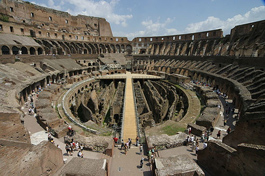
The Colosseum has started to tilt, and an urgent repair may be necessary
 |
Experts, according to the director of the monument, Rossella Rea, noticed the lean for the first time about a year ago and have been closely monitoring the site for the past few months.
Rea has asked scientists from the La Sapienza University in Rome and the IGAG geological institute to study the leaning Colosseum and present their findings within a year. Tests that have already begun will determine whether the changes in the structure's stability can be attributed to the heavy traffic near this nearly 2000-year-old monument.
Professor Giorgio Monti from La Sapienza University believes that the lean may be caused by a crack in the amphitheater's foundations.
"The concrete slab on which the Colosseum stands looks like a 13-meter-thick elliptical donut and may have a crack in it," Monti said.
If Monti's concerns are confirmed, intervention will be necessary, similar to the one carried out by experts on the world-famous Leaning Tower of Pisa. The tower was reopened in 2001 after more than ten years, following engineering efforts that saved it from collapse. However, Monti added that it is still too early to discuss what type of construction intervention would be most suitable.
The amphitheater, built on the initiative of the Roman Emperor Vespasian in the first century AD, served as an arena for games, gladiatorial contests, and animal fights. The Colosseum, with an elliptical layout featuring a double arcade and open stone and marble arcades, once stood 48 meters high, 189 meters long, and 156 meters wide. After the ban on games in the fifth century, it was abandoned and later suffered damage from several earthquakes and from being dismantled by residents of Rome. It has been on the UNESCO World Heritage List since 1980.
 |
The English translation is powered by AI tool. Switch to Czech to view the original text source.
0 comments
add comment




